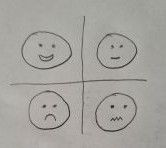How does Artificial Intelligence Recognise Human Smilies?

The Internet has become increasingly important in the past 20 years. There is more than 83 percent of the people who own a mobile device around the world. Moreover, more and more smart devices are being invented to include in our daily lives to improve the quality of life of the human race. Without a single thought, Artificial Intelligence(AI) has played the most important role in the development of the internet structure. Therefore, it is often called the greatest invention of the 21st century. In this article, I will explain how Artificial Intelligence recognizes human similes.
What is Artificial Intelligence?
The simple definition of AI is that it is a simulation of human intelligence processes by machines. Artificial Intelligence is created by humans, and it's usually in the form of a computer system. More specifically, a well developed artificial intelligence should have the human cognitive ability, which allows it to think logically and understand and learn new things as a human being. However, the most ideal AI should think rationally and act rationally, which implies that the intelligence of AI would exceed humans, and its intelligence will be limitless.
One might not have noticed that artificial intelligence is all around us. In fact, there are numerous applications of AI in our daily life, such as speech recognition, face recognition, voice assistance(Siri, Alexa) etc.

How does Artificial Intelligence recognise the human face?
Facial recognition is the process of identifying human faces in photos and videos. A strong AI and extensive machine learning is extremely important in having a highly accurate facial recognition algorithm.
Basic face recognition processes
- Face detection: identifying the faces of humans in the photos
- Face alignment: formatting the faces in a way that is consistent with the database
- Feature identification: identify the key features of the face. Usually, start by analysing from eyes, eyebrows, nose, mouth, nostrils, etc
- Face recognition: validation using comparison of features with photos in large data sets, comparing the results and making the final judgement
How does Artificial Intelligence recognise human smiles?
Machine learning is particularly important in analysing the human face. To be specific, in the machine learning process of facial recognition, AI uses different algorithms to analyse human faces from a large set of samples. Throughout the machine learning process, the algorithm of the AI would be improved by learning from different data. Eventually, it will be able to recognise human faces very accurately in seconds.
In terms of Artificial Intelligence recognising human similes, it is really similar to facial recognition. However, there are slight differences in the algorithm used. To begin with, a simple algorithm is being used in the first place. Then, the AI will be provided with a large set of photos that are with smiling faces, it allows the AI to analyse the photo and learn from every photo. During the machine learning process, it would improve its algorithm by learning from mistakes. And eventually, the AI would be able to identify human similes as accurately as humans do. However, there is an obstacle. It is difficult for AI to judge whether the smiles of humans are genuine or they are just fake smiles, as AI does not have human emotions.
Conclusion
It is really impressive that a machine can identify similes just like humans do. It is not only limited to detecting human smiles, AI can be further developed so that it can detect many kinds of emotions of humans. Therefore, it will definitely be useful in judging the emotion of patients that suffer from depression or any mental disorder. As a result, the fact that AI can learn at such a quick pace during the machine learning process shows that it has a huge potential for applications in different aspects of our daily lives, and AI is the future of the human race.
Reference
What Is AI, ML & How They Are Applied to Facial Recognition Technology | SuneraTech (2021). Available at: https://www.suneratech.com/blog/ai-ml-and-how-they-are-applied-to-facial-recognition-technology/#:~:text=How%20Does%20Facial%20Recognition%20Work,mouth%2C%20nostrils%2C%20and%20iris (Accessed: 21 July 2022).
What is Artificial Intelligence (AI)? Definition, Benefits and Use Cases (2022). Available at: https://www.techtarget.com/searchenterpriseai/definition/AI-Artificial-Intelligence (Accessed: 21 July 2022).
Brownlee, J. (2019) A Gentle Introduction to Deep Learning for Face Recognition, Machine Learning Mastery. Available at: https://machinelearningmastery.com/introduction-to-deep-learning-for-face-recognition/ (Accessed: 21 July 2022).
Education, I., 2022. What is Artificial Intelligence (AI)? [online] Ibm.com. Available at: <https://www.ibm.com/cloud/learn/what-is-artificial-intelligence> [Accessed 21 July 2022].
Author Biography
Jack Mok was born in 2004 in Hong Kong and is now studying in the sixth form at Huntington School, in York, in the UK. He is currently studying Maths, Further Maths, Chemistry and Physics as his A-level subjects. He is a joyful person who enjoys problem solving and likes to accept new challenges. Apart from his academic work, he also plays basketball in his free time, and he volunteers weekly in the local community.


Cite this article as:
Jack Mok, How does Artificial Intelligence Recognise Human Smilies?, theCircle Composition, Volume 3, (2022). https://theCircleComposition.org/how-does-artificial-intelligence-recognise-human-smilies/
